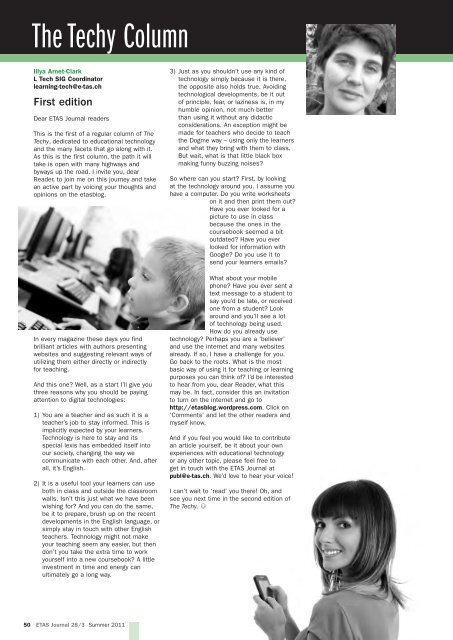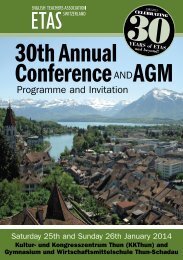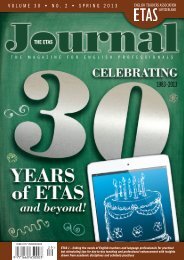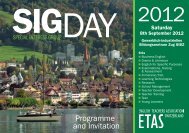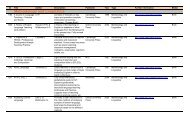Teaching English to Young Learners - English Teachers Association ...
Teaching English to Young Learners - English Teachers Association ...
Teaching English to Young Learners - English Teachers Association ...
You also want an ePaper? Increase the reach of your titles
YUMPU automatically turns print PDFs into web optimized ePapers that Google loves.
The Techy Column<br />
Illya Arnet-Clark<br />
L Tech SIG Coordina<strong>to</strong>r<br />
learning-tech@e-tas.ch<br />
First edition<br />
Dear ETAS Journal readers<br />
This is the first of a regular column of The<br />
Techy, dedicated <strong>to</strong> educational technology<br />
and the many facets that go along with it.<br />
As this is the first column, the path it will<br />
take is open with many highways and<br />
byways up the road. I invite you, dear<br />
Reader, <strong>to</strong> join me on this journey and take<br />
an active part by voicing your thoughts and<br />
opinions on the etasblog.<br />
In every magazine these days you find<br />
brilliant articles with authors presenting<br />
websites and suggesting relevant ways of<br />
utilizing them either directly or indirectly<br />
for teaching.<br />
And this one? Well, as a start I’ll give you<br />
three reasons why you should be paying<br />
attention <strong>to</strong> digital technologies:<br />
1) You are a teacher and as such it is a<br />
teacher’s job <strong>to</strong> stay informed. This is<br />
implicitly expected by your learners.<br />
Technology is here <strong>to</strong> stay and its<br />
special lexis has embedded itself in<strong>to</strong><br />
our society, changing the way we<br />
communicate with each other. And, after<br />
all, it’s <strong>English</strong>.<br />
2) It is a useful <strong>to</strong>ol your learners can use<br />
both in class and outside the classroom<br />
walls. Isn’t this just what we have been<br />
wishing for? And you can do the same,<br />
be it <strong>to</strong> prepare, brush up on the recent<br />
developments in the <strong>English</strong> language, or<br />
simply stay in <strong>to</strong>uch with other <strong>English</strong><br />
teachers. Technology might not make<br />
your teaching seem any easier, but then<br />
don’t you take the extra time <strong>to</strong> work<br />
yourself in<strong>to</strong> a new coursebook? A little<br />
investment in time and energy can<br />
ultimately go a long way.<br />
50 ETAS Journal 28/3 Summer 2011<br />
3) Just as you shouldn’t use any kind of<br />
technology simply because it is there,<br />
the opposite also holds true. Avoiding<br />
technological developments, be it out<br />
of principle, fear, or laziness is, in my<br />
humble opinion, not much better<br />
than using it without any didactic<br />
considerations. An exception might be<br />
made for teachers who decide <strong>to</strong> teach<br />
the Dogme way – using only the learners<br />
and what they bring with them <strong>to</strong> class.<br />
But wait, what is that little black box<br />
making funny buzzing noises?<br />
So where can you start? First, by looking<br />
at the technology around you. I assume you<br />
have a computer. Do you write worksheets<br />
on it and then print them out?<br />
Have you ever looked for a<br />
picture <strong>to</strong> use in class<br />
because the ones in the<br />
coursebook seemed a bit<br />
outdated? Have you ever<br />
looked for information with<br />
Google? Do you use it <strong>to</strong><br />
send your learners emails?<br />
What about your mobile<br />
phone? Have you ever sent a<br />
text message <strong>to</strong> a student <strong>to</strong><br />
say you’d be late, or received<br />
one from a student? Look<br />
around and you’ll see a lot<br />
of technology being used.<br />
How do you already use<br />
technology? Perhaps you are a ‘believer’<br />
and use the internet and many websites<br />
already. If so, I have a challenge for you.<br />
Go back <strong>to</strong> the roots. What is the most<br />
basic way of using it for teaching or learning<br />
purposes you can think of? I’d be interested<br />
<strong>to</strong> hear from you, dear Reader, what this<br />
may be. In fact, consider this an invitation<br />
<strong>to</strong> turn on the internet and go <strong>to</strong><br />
http://etasblog.wordpress.com. Click on<br />
‘Comments’ and let the other readers and<br />
myself know.<br />
And if you feel you would like <strong>to</strong> contribute<br />
an article yourself, be it about your own<br />
experiences with educational technology<br />
or any other <strong>to</strong>pic, please feel free <strong>to</strong><br />
get in <strong>to</strong>uch with the ETAS Journal at<br />
publ@e-tas.ch. We’d love <strong>to</strong> hear your voice!<br />
I can’t wait <strong>to</strong> ‘read’ you there! Oh, and<br />
see you next time in the second edition of<br />
The Techy. U


